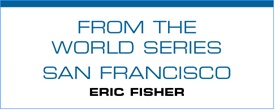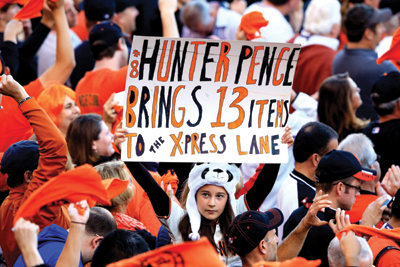Since AT&T Park in 2004 became the first professional stadium to offer free Wi-Fi, it has been a key barometer of fan demand for in-venue bandwidth. And for much of the past decade, San Francisco Giants officials have been in a constant chase to boost capacity and keep up with that demand, continually adding more access points and other hardware to expand the Wi-Fi network. The latest upgrades involved placing additional antennas underneath seats and attached to some handrails.
 |
This year’s World Series illuminated a tipping point after all that chasing and worry. The traffic data from the three games at AT&T Park was predictably historic: The record 1.57 terabytes of data transmitted for Game 3 alone on Oct. 24 was nearly five times the 370 gigabytes of data transmitted during the Giants’ first home game of the 2012 World Series. The Giants then topped that number again the following night with 1.62 terabytes of transmitted data. And for each of the three Giants home games in the series, roughly half of the 43,000 attendees at AT&T Park accessed the network, up from 38 percent two years ago and 18 percent during the 2010 World Series.
The comparisons are particularly enlightening, as they are measuring the same ballpark, same network, and same event across the four-year span of time.
But this year, there were no major struggles for the Wi-Fi to keep up with the surging demand. Team officials have grown so confident in the strength of the network that they have begun to add meaningful business initiatives that depend on that network, such as seat upgrades in partnership with Pogoseat, mobile food ordering with concessionaire Centerplate, and mobile check-ins. Several other projects, particularly around mobile commerce, are being explored for the 2015 season.
“I feel as good as I ever have about our network,” said Bill Schlough, Giants senior vice president and chief information officer. “We can now really rely on it, and that gives us the confidence to really start doing some interesting things on top of that network. Beyond just a fan amenity, the network can now be a real business driver for us.”
SOCIAL SURGE: Much of the digital traffic spike at AT&T Park owed to social media, particularly fans pushing out photos and videos taken in the ballpark. The Giants’ social media team, already lauded within the industry as a thought leader, worked to make sure they were a key part of that conversation.
Bryan Srabian, the Giants’ director of digital media, and his team managed a five-pronged social media deployment plan during the World Series that involved official team destinations on Twitter, Facebook, Instagram, Vine and Snapchat.
Predictably, the use cases for each differed. Twitter was devoted mainly to in-game updates and highlights. Facebook posts were focused on those that would have a longer shelf life. The photo-based platforms Instagram and Snapchat received more attention during pregame and postgame windows, and Vine often was used to show short vignettes of fan reaction to key moments in the games.
The demands represented a marked difference from even two years ago, when Vine and Snapchat barely existed and had yet to reach mass acceptance, and now-common social media tools such as GoPro cameras were also not yet fully in the mainstream.
 |
The social meme #HunterPenceSigns, started in August, took on a life its own during the Series.
Photo by: GETTY IMAGES
|
“It’s a such a different set of demands we have now, particularly around an event like the World Series,” Srabian said. “There’s so much more demand for photos and video. But fortunately, we now have the tools to do that.”
The Giants’ 698,000 followers on their official Twitter feed is about seven times the level of four years ago. But much more critical than raw follower reach, Srabian is actively measuring engagement in real time using an analytics dashboard developed by Adobe Social. Among the findings there: Fans were particularly gravitating toward further posts hashtagged with #HunterPenceSigns. The social meme playfully mocking the popular outfielder started in August, but became a full-on phenomenon during the World Series and one in which Pence himself happily participated.
“Every time something around the Pence signs went out, we’ve seen a huge spike,” Srabian said. “It’s been incredible.”
This year’s World Series marked the first such games since the opening last year of the club’s social media center, the @Cafe. The destination, carrying a “Powered By” sponsorship from Jive Software, became a focal point during the Series for the Giants’ most socially active fans.
“We obviously didn’t have anything like that before for the World Series, but it’s just been another proof point that it could work, be a destination for the fans, and also could work as a sponsored asset,” Srabian said.
The Giants during the World Series also executed a social media-based promotion with rideshare service Lyft. Newly signed as the exclusive rideshare partner of MLB.com, Lyft offered free rides to AT&T Park and drawings for Lyft credits to fans posting pictures on Twitter and Instagram with special Lyft hashtags.





